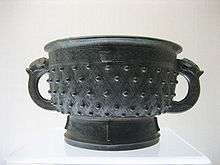Houmuwu ding

The Houmuwu ding (Chinese: 后母戊鼎; pinyin: Hòumǔwù dǐng), formerly called Simuwu ding (Chinese: 司母戊鼎; pinyin: Sīmǔwù dǐng), is a rectangular bronze ding (sacrificial vessel, one of the common types of Chinese ritual bronzes) of the ancient Chinese Shang dynasty. It is the largest piece of bronzeware to survive from anywhere in the ancient world.[1] It was unearthed in Wuguan Village, Anyang, Henan in 1939.
Owner
The ding is named for the inscription in bronze ware script on the interior wall, which reads "Queen Mother Wu" (Chinese: 后母戊; pinyin: Hòumǔwù).[2] This is the temple name of Fu Jing, a queen of Wu Ding.[3] The ding was made after her death, presumably by her son, Zu Geng of Shang.[4] Whilst the ding itself was unearthed in 1939, Fu Jing's tomb[5] was not located until 1959, and was found to have been robbed out.[4]
Description

The ding is of the rectangular type, with four legs. It is 133 centimetres high, 110 centimetres wide, 79 centimetres deep, and weighs 832.84 kilograms.[2] Compared to earlier ding, such as the Duling rectangular ding, it is wider and its walls are thicker, making it much more massive.[6] Each side has a blank space in the middle, surrounded by a band of decoration featuring taotie (animal faced creatures) and kuilong (one-legged dragons).[6] There are two handles, each decorated on the exterior with two tigers facing each other, their jaws closing around a human head in between them, an image which is also found on Fu Hao battle axes.[6]
Inscription debate
The inscription was originally read as sīmǔwù (司母戊), but since the 1970s scholars have reached the consensus that the first character should be read as hou (后), meaning queen, which is the mirror-image of si (司) in oracle bone script. The National Museum of China has officially corrected its name.[7] This reading of the inscription meant that the owner of the ding was supposed to have been a wife of Wu Yi of Shang (reigned c. 1147–1112 BC),[8][9] and the dedicator her son, Wen Ding[2] (reigned c. 1112–1102 BC).[9][10] However, understanding the first character as hou makes it the temple name of Fu Jing, who lived earlier.[3]
References
- ↑ "The National Museum of China". China Culture. Archived from the original on 2014-05-27.
- 1 2 3 Li Song. Chinese Bronze Ware (Cambridge: Cambridge University Press, 2011, ISBN 978-0-521-18685-8), p. 28.
- 1 2 Zeng (1993), p. 71.
- 1 2 Li (2012), p. 13.
- ↑ Yinxu, tomb 260
- 1 2 3 Li Song. Chinese Bronze Ware, p. 30.
- ↑ ""Houmuwu Quadripod" debuts at National Museum of China". CCTV. 28 March 2011. Retrieved 20 January 2014.
- ↑ Shang Kingship and Shang Kinship
- 1 2 The Cambridge History of Ancient China
- ↑ Shang Dynasty by N.S. Gill, About.com Guide
Bibliography
- Li 李, Xueqin 学勤 (2012). "谈新出现的妇妌爵" [On the newly discovered jue of Fu Jing]. Wenbo (in Chinese) (3): 13–14.
- Zeng 曾, Wenqing 文清 (1993). "关于"司母戊""司母辛"大方鼎的"司"字质疑" [On the question of the si character on the Simuwu-Simuxin great square ding]. Huaihua Shizhuan Xuebao (in Chinese). 21 (4): 71–73.
